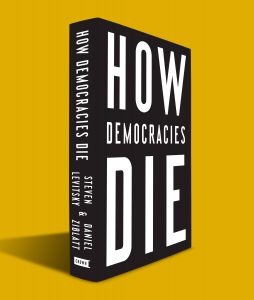
Book Review: How democracies die, by Steven Levitsky and Daniel Ziblatt, 2018

Introduction
Steven Levitsky and Daniel Ziblatt are both professors of government at Harvard University. One studies Latin America and the developing world, the other focuses on Europe from the nineteenth century to the present. The association of both specialties applied to political situation in America gives “How Democracies die”.
They demonstrate how a democracy can be destroyed from inside by elected autocrats.
Summary
Democracy in danger
According to the Authors, an autocrat can take power by violence with, for example, a military coup d’état or a putsch. But he can also take power in a rather discrete way by fooling the population on his true aspirations. Indeed, a potential dictator is generally charismatic and appears as a saviour of the nation, especially in a time of crisis. Political parties may join forces with him to win electorates without seeing the danger he represents. Once in power, he uses democratic laws to internally destroy democracy and its institutions and thus remain in power.
It should be possible recognize an autocrat through a “democratic test”, inspired by Linz:
- Rejection of (or weak commitment to) democratic rules of the game
- Denial of the legitimacy of political opponents
- Tolerance or encouragement of violence
- Readiness to curtail civil liberty of opponents, including media
Gatekeeping in America
In the USA, there were traditionally gatekeepers of democracy who protected democracy by choosing the candidates for elections.: political parties. The candidates were chosen in “smoke-filled” room by power brokers. This selection was not a very democratic procedure, but it has the role of “choosing a popular candidate and keeping out demagogues”. Gatekeeping institutions go back to the founding of the American republic.
In 1968, the system evolved so that the people choose these candidates. Today, gatekeepers highlight favourites while trying to dismiss demagogues, but they are less effective than in the past. Since this reform, the number of outsiders has increased significantly. Thanks to new media, the population is less polarized and sometimes vote for extremist positions. Elections are normalized and people vote for their favourite party.
This is a potential danger to democracy. The paradox is that to guarantee it, we need a slightly less democratic system.
The great republican abdication
It is in this context that the candidate Trump emerged. He managed to get through all the roadblocks placed by the gatekeepers thanks to funding for the invisible primary, then the primary and finally the elections.
Applying the test inspired by Linz to all presidents for 100 years, we can observe that he is the only one to fulfil all the criteria:
- In case of defeat he would not have accepted the result of the elections, he clearly stated that the elections would be rigged and completely questioned the American democratic system. He thus completes the first criterion which is the refusal of the rules of the democratic game;
- He described his opponents as criminals by saying that Obama was not American and advocating that Clinton should be jailed. He therefore denies the legitimacy of his opponents and adheres to the second criterion;
- He refused to condemn the violence of his supporters and is himself very verbally abusive and confirms the third criterion, tolerance or encouragement of violence;
- And finally, he asked a prosecutor to investigate Clinton and represses the media who criticize him by threatening them and banning them from the White House. So, we have the hindrances to the civil liberties of its opponents and the media.
Trump has all the characteristics of authoritarian behavior and the problem is that the Republican Party supports it thoroughly.
This was not the case for all countries facing the rise of populist candidates. In Belgium in the 1930’s, political parties faced an increase in votes for the Nationalist party (the Rex Party and the Vlaams National Verbond). The three historic parties (Catholic Party, the Socialists and the Liberal Party) decided to form a coalition against their own interests in order to protect democracy from the fascist threat.
Subverting democracy
In general, the end of democracy happens insidiously, measure by measure, reform by reform
to silence the opponents. Take for example the end of the 19th century in the USA; the Democrats saw their score drop drastically when the African American population were given the vote. Indeed, this new population, having freshly received the right to vote, put it in favour the Republicans. The Democrats then passed a law requiring voters to do a language test to limit access to the polls of the African American population, who were still poorly literate because they had recently been released from slavery. Through this reform, the Democrats regained majority.
We can see how, to serve one's own interests, a party can amputate or manipulate democracy.
For democracy to work, the people must have great confidence in the constitution, and in democratic institutions and organizations. What is also fundamental is that leaders respect the "unwritten rules" because the constitution does not work by itself. As James Bryce said: “It is not the American constitution that made the American political system work, but rather what he called "usages".”
All participants must adhere to some basic principles as “mutual tolerance and forbearance”.
These norms are the sine qua non condition for the democracy to exist and they lately, have been overridden.
Critical Review
About the subject covered by the book "How democracies die"
“ … there is another way to break a democracy. It is less dramatic but equally destructive. Democracies may die at the hands not of generals but of elected leaders - president or prime ministers - who subvert the very process that brought them to power. Some of these leaders dismantle democracy quickly, as Hitler did in the wake of the 1933 Reichstag fire in Germany. More often, though, democracies erode slowly, in barely visible steps.” (p.3)
The main question the authors attempt to answer, how democracies die, is not new. It was already asked by the Greek philosophers. Nothing interested Aristotle (Politics) more than two questions: How is a democratic system maintained? How does a democratic regime change or is it overthrown to make way for tyranny? Alexis de Tocqueville, who had studied United States politics, also asked the same question: Western societies inevitably move towards equality; therefore, the question that arises is whether an egalitarian society will be liberal or tyrannical.
Main characteristics of a demagogue
“… demagogue’s initial rise to power tends to polarize society, creating a climate of panic hostility, and mutual distrust.” (p.76)
Many pages of the book are devoted to describing the known populist as Donald Trump but also Mussolini, Hitler, Chavez and many other autocrats. There appear to them several points in common: the fact of being in a balance of power and not in the debate, their clear designation of the enemy of the nation that must be eradicated and which echoes the nationalist electorate, the period of their rise to power is always made during a major crisis in the country with a speech full of promise flattering the people.
“President Trump exhibited clear authoritarian instinct during his first year in office. … Three strategies by which elected authoritarians seek to consolidate power: capturing the referees, sidelining the key players and rewriting the rules to tilt the playing field against opponents. Trump attempted all three of these strategies.” (p.177)
The book gives in fact many examples of the characteristics of a demagogue or a tyrant in the sense this notion was defined by the Greek philosophers.
Machiavel (The Prince) already provided the governors of each regime with advice on the best way to preserve the existing regime. If a tyrannical regime is bad, the means necessary to maintain it will also be bad: they will be detestable, contrary to morality. In this line, W. Pareto introduced a simple classification of political regimes according to the psycho-social character of the governing people: the ones are lions (preferably using the force), the others are foxes (using cunning, speech and speculation).
The 4 cumulative criteria to decode an autocrat
The authors developed a litmus test to help identify would-be autocrats before they come to power. The book states four negative criteria to detect an autocrat: challenging the legitimacy of the winner; delegitimizing his opponents, encouraging violence and questioning political freedoms. These criteria are in fact the mirror of the criteria set out by Raymond Aron (Democracy and Totalitarianism) that form the basis of a democracy. For this liberal thinker, democracy is based on peaceful electoral competition for the exercise of power. This definition presupposes the existence of two or more political parties (“gatekeepers” in the sense given by the Authors) and therefore the following four positive criteria: the loser must not contest the result of the elections (accepting the democratic rules of the game), the loser must be able to express his opposition and compete in the next election (legitimacy of the opponent), each opponent must respect the rules of the game (competition must be peaceful and not be resolved by violence) and citizens must be able to express their opinion without risking going to prison (political freedom).
Unwritten rules
“Democracy, of course, is not street basketball. Democracies do have written rules (constitution) and referees (the courts). But these work best, and survive longest, in countries where written constitution is reinforced by their own unwritten rules of the game. This rules or norms serve as the soft guardrails of democracy, preventing day-to-day political competition from devolving into a no-holds-barred conflict”. (p.101)
The book refers to two unwritten rules: mutual toleration and forbearance.
This is what Montesquieu (Esprit des Lois) - pointed p.213 - refers to when he speaks of the "distribution of powers". Power must stop power in order to avoid absolutism. The result is a set of written and unwritten rules where, as on a chess game, each power has a specific place on the political chessboard and advances its pieces according to precise rules. The example of the battle between the executive power and the English Parliament on Brexit is the most current example.
Conclusion
The authors can be classified as "liberal" political scientists since they use many concepts of this school of thought (Baron de Montesquieu, Alexis de Tocqueville, Raymond Aron, etc.), even if these authors are rarely or never mentioned.
They oppose Marxist political scientists who through analysis of economics and conflict between social classes attempt to explain the end of democracy. Marx believed that capitalist societies were affected by fundamental contradictions and that, consequently, they would undoubtedly go towards a revolutionary explosion. The subject is completely absent in the book.
This is a fairly classic book of liberal thinkers. But it is interesting because it applies their concepts to current topics.
Bibliography
Books
- Raymond Aron, Démocratie et totalitarisme. (Gallimard,1965).
- Raymond Aron, Les étapes de la pensée sociologique. Montesquieu, Comte, Marx, Tocqueville, Durkheim, Pareto, Weber. (Gallimard, 1967).
- Alexis de Tocqueville, La démocratie en Amérique. (L'Harmattan, 2005).
- Nicolas Machiavel, Le Prince. (Broché, 2007).
- Aristote, La politique. (Broché, 1995).
Articles
- Steven Levitsky and Daniel Ziblatt, How Democracies Die Teacher’s Guide. (The Penguin Random House, n.a.). Accessed 20 Oct. 2019
- David Runciman, How Democracies Die review – Trump and the shredding of norms. (The Guardian, 24 Jan. 2018). Accessed 13 Oct. 2019
- Mathilde Damgé, En carte : la progression des extrêmes droites en Europe. (Le Monde, 11 Sep. 2018). Accessed 13 Oct. 2019
- Julien Licourt, Que pèse réellement l’extrême droite en Europe ? (Le Figaro, 1 Dec. 2016). Accessed 13 Oct. 2019
- Alexis Feertchak, Tour du monde des pays touchés par la vague du populisme. (Le Figaro International, 27 Oct. 2018). Accessed 13 Oct. 2019
Videos
- Review: How Democracies Die by Steven Levitsky and Daniel Ziblatt. (CaspianReport, 29 Mar. 2019). Accessed 20 Oct. 2019
- Daniel Ziblatt, How Democracies Die. (The Brainwaves Video Anthology, 12 Apr. 2018). Accessed 20 Oct. 2019